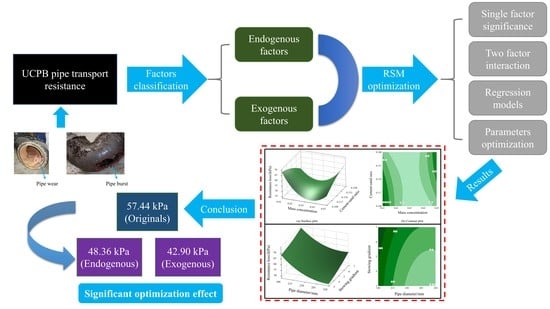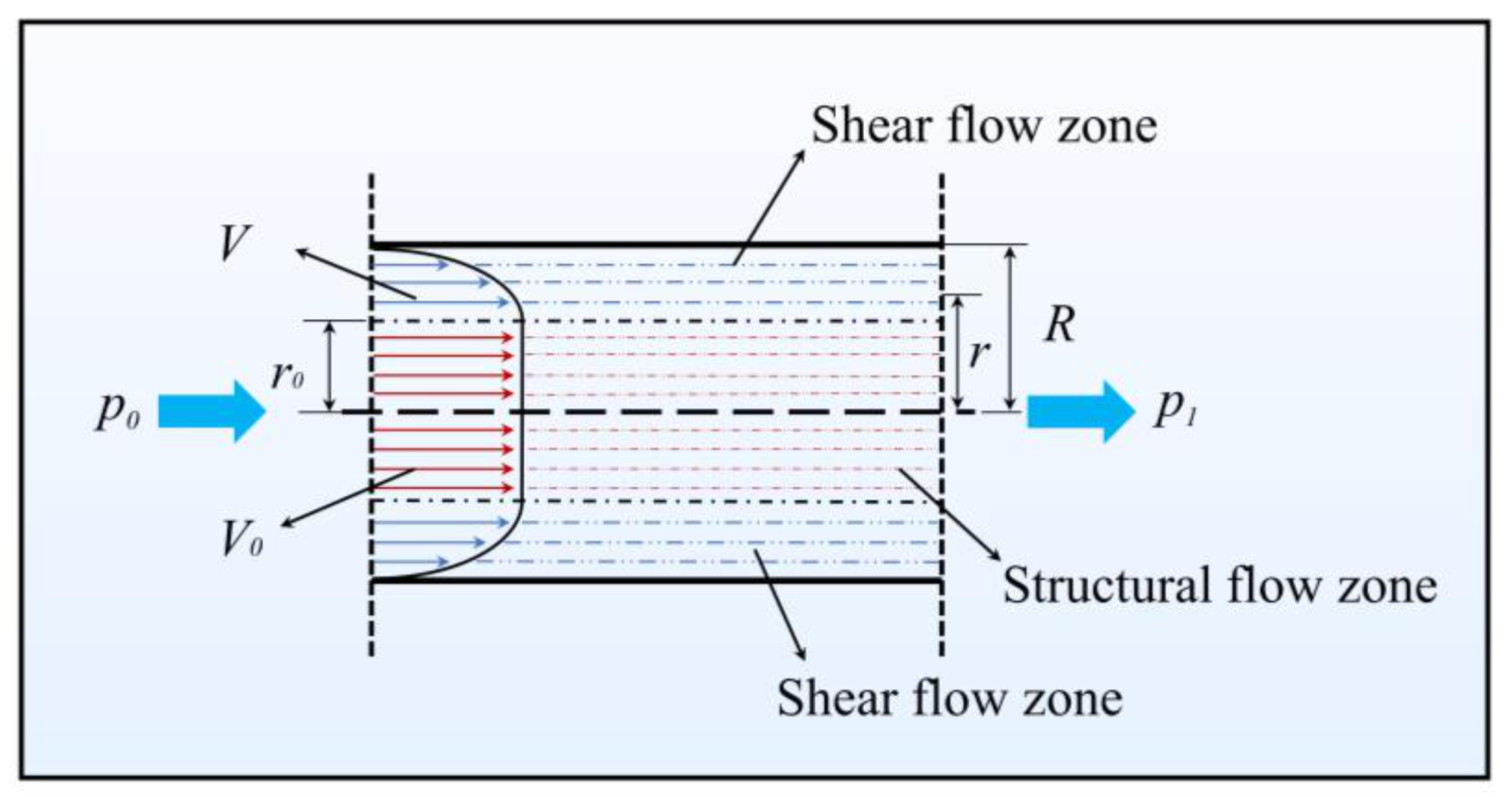Categorization of Factors Affecting the Resistance and Parameters Optimization of Ultra-Fine Cemented Paste Backfill Pipeline Transport
Abstract
1. Introduction
2. Factors Influencing the Pipe Transport Resistance of UCPB
2.1. Pipeline Transport Resistance Model
2.2. Classification of Influencing Factors
3. Materials and Methods
3.1. Test Materials
3.1.1. Tailings and Binder
3.1.2. UCPB
3.2. Test Methods
3.2.1. Rheological Test
3.2.2. Pipeline Transport Simulation Test
3.2.3. Response Surface Test Based on Central Composite Designs
4. Analysis of Test Results
4.1. Regression Model of Pipeline Transport Resistance
4.2. Effect of Endogenous Factors
4.2.1. Variance Analysis
4.2.2. Endogenous Factors Interaction
4.3. Effect of Exogenous Factors
4.3.1. Variance Analysis
4.3.2. Exogenous Factor Interaction
5. Engineering Optimization
5.1. Optimization Results
5.2. Results Validation
6. Discussion
7. Conclusions
- The influencing factors of UCPB resistance are categorized and integrated into endogenous and exogenous effects. The endogenous factors include mass concentration, cement–sand ratio, and slurry temperature, which change the plastic viscosity and yield stress of UCPB and thus the pipeline resistance. The exogenous factors include pipe diameter, flow velocity, and stowing gradient.
- The sensitivity for the effect of endogenous factors on the UCPB pipe transport resistance is mass concentration > slurry temperature > cement–sand ratio. The sensitivity for the interaction effect is mass concentration and slurry temperature > mass concentration and cement–sand ratio > cement–sand ratio and slurry temperature. The sensitivity order of univariate factors for UCPB pipe transport resistance under the influence of exogenous factors is pipe diameter > flow velocity > stowing gradient. The order of sensitivity under the interaction effect is pipe diameter and flow velocity > pipe diameter and stowing gradient > flow velocity and stowing gradient.
- Regression models were constructed for different categories of factors and UCPB pipe transport resistance. When the exogenous factors were fixed, the optimized UCPB properties were: 63% mass concentration, 1:6 cement–sand ratio, and 47.2 °C slurry temperature. When the endogenous factors were fixed, the optimized pipe design parameters were: pipe diameter 320 mm, flow velocity 1.67 m/s, and stowing gradient 3. The mine should make corresponding changes to the filling pipeline design based on the comprehensive analysis of economy and convenience to reduce the pipeline resistance.
Author Contributions
Funding
Data Availability Statement
Conflicts of Interest
References
- Kleib, J.; Amar, M.; Aouad, G.; Bourbon, X.; Benzerzour, M.; Abriak, N.-E. The Use of Callovo-Oxfordian Argillite as a Raw Material for Portland Cement Clinker Production. Buildings 2022, 12, 1421. [Google Scholar] [CrossRef]
- Daher, J.; Kleib, J.; Benzerzour, M.; Abriak, N.-E.; Aouad, G. Recycling of Flash-Calcined Dredged Sediment for Concrete 3D Printing. Buildings 2022, 12, 1400. [Google Scholar] [CrossRef]
- Jiao, H.Z.; Chen, W.L.; Wu, A.X.; Yu, Y.; Ruan, Z.E.; Honaker, R.; Chen, X.M.; Yu, J.X. Flocculated unclassified tailings settling efficiency improvement by particle collision optimization in the feedwell. Int. J. Miner. Metall. Mater. 2022. [Google Scholar] [CrossRef]
- Kragović, M.; Stojmenović, M.; Ristić, N.; Milićević, S.; Živković, S.; Liu, S.-K.; Gulicovski, J. Application of the Hazardous Waste Vitreous Enamel Generated in the Production Process of Heating Devices as a Partial Replacement for Cement. Buildings 2022, 12, 1287. [Google Scholar] [CrossRef]
- Bartulović, B.; Juradin, S.; Žižić, D.; Galić, M. Influence of Cotton Knitted Fabric Waste Addition on Concrete Properties. Buildings. 2022, 12, 1121. [Google Scholar] [CrossRef]
- Jiao, H.Z.; Wu, Y.C.; Wang, H.; Chen, X.M.; Li, Z.; Wang, Y.F.; Zhang, B.Y.; Liu, J.H. Micro-scale mechanism of sealed water seepage and thickening from tailings bed in rake shearing thickener. Miner. Eng. 2021, 173, 107043. [Google Scholar] [CrossRef]
- Suppes, R.; Heuss-aßbichlerc, S. Resource potential of mine wastes: A conventional and sustainable perspective on a case study tailings mining project. J. Cleaner Prod. 2021, 297, 126446. [Google Scholar] [CrossRef]
- Bilibio, C.; Retz, S.; Schellert, C.; Hensel, O. Drainage properties of technosols made of municipal solid waste incineration bottom ash and coal combustion residues on potash-tailings piles: A lysimeter study. J. Clean. Prod. 2021, 279, 123442. [Google Scholar] [CrossRef]
- Li, Z.F.; Zhang, J.; Li, S.C.; Lin, C.J.; Gao, Y.F.; Liu, C. Feasibility of preparing red mud-based cementitious materials: Synergistic utilization of industrial solid waste, waste heat, and tail gas. J. Clean. Prod. 2021, 285, 124896. [Google Scholar] [CrossRef]
- Guo, D.F.; Hou, H.M.; Long, J.; Guo, X.Y.; Xu, H. Underestimated environmental benefits of tailings resource utilization: Evidence from a life cycle perspective. Environ. Impact Asses. 2022, 96, 106832. [Google Scholar] [CrossRef]
- Wu, F.; Liu, X.; Qu, G.; Ning, P.; Jin, C.; Cui, Q.; Ren, Y.; He, M.; Yang, Y.; Li, J. Solidification and stabilization of harmful elements in antimony tailings and synergistic utilization of multiple solid wastes. Cem. Concr. Compos. 2022, 133, 104718. [Google Scholar] [CrossRef]
- Gao, W.; Ni, W.; Zhang, Y.Y.; Li, Y.Y.; Shi, T.Y.; Li, Z.F. Investigation into the semi-dynamic leaching characteristics of arsenic and antimony from solidified/stabilized tailings using metallurgical slag-based binders. J. Hazard. Mater. 2020, 381, 120992. [Google Scholar] [CrossRef] [PubMed]
- Li, Y.Y.; Ni, W.; Gao, W.; Zhang, S.Q.; Fu, Q.F.; Li, Y. Study on Solidification and Stabilization of Antimony-Containing Tailings with Metallurgical Slag-Based Binders. Mater 2022, 15, 1780. [Google Scholar] [CrossRef] [PubMed]
- Adigamov, A.; Zotov, V.; Kovalev, R.; Kopylov, A. Calculation of transportation of the stowing composite based on the waste of water-soluble ores. Transport. Res. Procedia. 2021, 57, 17–23. [Google Scholar] [CrossRef]
- Khayrutdinov, M.M.; Kongar-Syuryun, C.B.; Tyulyaeva, Y.S.; Khayrutdinov, A.M. Cementless backfill mixtures based on water-soluble manmade waste. Bull. Tomsk. Polytech. 2020, 331, 30–36. [Google Scholar]
- Ermolovich, E.A.; Ivannikov, A.L.; Khayrutdinov, M.M.; Kongar-Syuryun, C.B.; Tyulyaeva, Y.S. Creation of a Nanomodified Backfill Based on the Waste from Enrichment of Water-Soluble Ores. Materials 2022, 15, 3689. [Google Scholar] [CrossRef]
- Cao, H.; Gao, Q.; Zhang, X.Z. Research Progress and Development Direction of Filling Cementing Materials for Filling Mining in Iron Mines of China. Gels 2022, 8, 192. [Google Scholar] [CrossRef]
- Wu, J.; Feng, M.; Xu, J.; Qiu, P.; Wang, Y.; Han, G. Particle Size Distribution of Cemented Rockfill Effects on Strata Stability in Filling Mining. Miner 2018, 8, 407. [Google Scholar] [CrossRef]
- Xing, B.D.; Fan, W.Y.; Lyu, Y.C.; Sun, H.D.; Che, J.L. Influence of particle mineralogy and size on the morphological characteristics of mineral fillers. J. Mater. Res. Technol. 2021, 15, 3995–4009. [Google Scholar] [CrossRef]
- Xue, Z.L.; Gan, D.Q.; Zhang, Y.Z.; Liu, Z.Y. Rheological behavior of ultrafine-tailings cemented paste backfill in high-temperature mining conditions. Constr. Build. Mater. 2020, 253, 119212. [Google Scholar] [CrossRef]
- Li, M.; Xiang, Y.; Chen, T.; Gao, X.; Liu, Q. Separation of ultra-fine hematite and quartz particles using asynchronous flocculation flotation. Miner. Eng. 2021, 164, 106817. [Google Scholar] [CrossRef]
- Guo, Z.B.; Qiu, J.P.; Jiang, H.Q.; Xing, J.; Sun, X.G.; Ma, Z.Y. Flowability of ultrafine-tailings cemented paste backfill incorporating superplasticizer: Insight from water film thickness theory. Powder Technol. 2021, 381, 509–517. [Google Scholar] [CrossRef]
- Li, S.; Wang, X.M.; Zhang, Q.L. Dynamic experiments on flocculation and sedimentation of argillized ultrafine tailings using fly-ash-based magnetic coagulant. Trans. Nonferrous Met. Soc. China. 2016, 26, 1975–1984. [Google Scholar] [CrossRef]
- Wei, C.B.; Apel, D.; Zhang, Y.H. Shear behavior of ultrafine magnetite tailings subjected to freeze-thaw cycles. Int. J. Min. Sci. Technol. 2019, 29, 609–616. [Google Scholar] [CrossRef]
- Amaral, L.M.D.; Rodrigues, C.; Poggiali, F. Hornification on vegetable fibers to improve fiber-cement composites: A critical review. J. Build. Eng. 2021, 48, 103947. [Google Scholar] [CrossRef]
- Thanushan, K.; Sathiparan, N. Mechanical Performance and Durability of Banana Fibre and Coconut Coir Reinforced Cement Stabilized Earth Blocks. SSRN Electron. J. 2021, 21, 101309. [Google Scholar] [CrossRef]
- Zhao, Y.L.; Ma, Z.Y.; Qiu, J.P.; Sun, X.G.; Gu, X.W. Experimental study on the utilization of steel slag for cemented ultra-fine tailings backfill. Powder Technol. 2020, 375, 284–291. [Google Scholar]
- Zhang, M.; Li, K.; Ni, W.; Zhang, S.; Liu, Z.; Wang, K.; Wei, X.; Yu, Y. Preparation of mine backfilling from steel slag-based non-clinker combined with ultra-fine tailing. Constr. Build. Mater. 2022, 320, 126248. [Google Scholar] [CrossRef]
- Panda, L.; Biswal, S.K.; Venugopal, R. Recovery of Ultra-Fine Iron Ore from Iron Ore Tailings. Trans. Indian Inst. Met. 2018, 71, 463–468. [Google Scholar] [CrossRef]
- Li, W.C.; Fall, M. Strength and self-desiccation of slag-cemented paste backfill at early ages: Link to initial sulphate concentration. Cem. Concr. Compos. 2018, 89, 160–168. [Google Scholar] [CrossRef]
- Xin, J.; Liu, L.; Long, H.X.; Wang, J.Y.; Yang, P.; Qu, H.S. A preliminary study of aeolian sand-cement-modified gasification slag-paste backfill: Fluidity, microstructure, and leaching risks. Sci. Total Environ. 2022, 830, 154766. [Google Scholar] [CrossRef] [PubMed]
- Kaushal, D.R.; Sato, K.; Toyota, T.; Funatsu, K.; Tomita, Y. Effect of particle size distribution on pressure drop and concentration profile in pipeline flow of highly concentrated slurry. Int. J. Multiph. Flow. 2005, 31, 809–823. [Google Scholar] [CrossRef]
- Ren, W.; Gao, R.; Zhang, Y.; Hou, M. Rheological Properties of Ultra-Fine Tailings Cemented Paste Backfill under Ultrasonic Wave Action. Minerals 2021, 11, 718. [Google Scholar] [CrossRef]
- Cheng, H.Y.; Wu, S.C.; Li, H.; Zhang, X.Q. Utilization of mill tailings, fly ash and slag as mine paste backfill material: Review and future perspective. Constr. Build. Mater. 2020, 231, 117117. [Google Scholar] [CrossRef]
- Zhou, S.H.; Li, X.; Ji, C.; Xiao, J. Back-fill grout experimental test for discharged soils reuse of the large-diameter size slurry shield tunnel. KSCE J. Civ. Eng. 2017, 21, 725–733. [Google Scholar] [CrossRef]
- Wu, A.; Ruan, Z.; Bürger, R.; Yin, S.; Wang, J.; Wang, Y. Optimization of flocculation and settling parameters of tailings slurry by response surface methodology. Miner. Eng. 2020, 156, 106488. [Google Scholar] [CrossRef]
- Bayramov, F.; Taşdemir, C.; Taşdemir, M.A. Optimization of steel fiber reinforced concretes by means of statistical response surface method. Cem. Concr. Compos. 2004, 26, 665–675. [Google Scholar] [CrossRef]
- Mohammed, B.S.; Fang, O.C.; Hossain, K.M.A.; Lachemi, M. Mix proportioning of concrete containing paper mill residuals using response surface methodology. Constr. Build. Mater. 2012, 35, 63–68. [Google Scholar] [CrossRef]
- Fall, M.; Benzaazoua, M.; Saa, E.G. Mix proportioning of underground cemented tailings backfill. Tunn. Undergr. Sp. Tech. 2008, 23, 80–90. [Google Scholar] [CrossRef]
- Ofuyatan, O.M.; Agbawhe, O.B.; Omole, D.O.; Igwegbe, C.A.; Ighalo, J.O. RSM and ANN modelling of the mechanical properties of self-compacting concrete with silica fume and plastic waste as partial constituent replacement. Clean. Mater. 2022, 4, 100065. [Google Scholar] [CrossRef]
- Zhu, L.L.; Jin, Z.H.; Zhao, Y.; Duan, Y. Rheological properties of cemented coal gangue backfill based on response surface methodology. Constr. Build. Mater. 2021, 306, 124836. [Google Scholar] [CrossRef]
- Hamada, H.M.; Al-Attar, A.A.; Tayeh, B.; Yahaya, F.B.M. Optimizing the concrete strength of lightweight concrete containing nano palm oil fuel ash and palm oil clinker using response surface method. Case Stud. Constr. Mat. 2022, 16, e01061. [Google Scholar] [CrossRef]
- Fauzi, M.A.; Arshad, M.F.; Md Nor, N.; Ghazali, E. Modeling and optimization of properties for unprocessed-fly ash (u-FA) controlled low-strength material as backfill materials. Clean. Eng. Tech. 2022, 6, 100395. [Google Scholar] [CrossRef]
- Long, T.Y.; Cai, Z.J. Fluid mechanics, 3rd ed.; China Architecture & Building Press: Beijing, China, 2019; pp. 92–118+177–218. [Google Scholar]
- Pragya, M.; Tiwari, A.K.; Chhabra, R.P. Effect of orientation on the drag of a cone settling in a Bingham plastic fluid. Particuology 2018, 43, 157–170. [Google Scholar]
- Naramgari, S.; Olubode, K.K.; Isaac, L.A. Modified kinematic viscosity model for 3D-Casson fluid flow within boundary layer formed on a surface at absolute zero. J. Mol. Liq. 2016, 221, 1197–1206. [Google Scholar]
- Gupta, A.K.; Mishra, P.; Chhabra, R.P. Momentum and heat transfer characteristics of a thin circular disk in Bingham plastic fluids. Numer. Heat Transfer. Part A 2017, 72, 844–868. [Google Scholar] [CrossRef]
- Chiloane, N.M.; Mulenga, F.K. Revisiting factors contributing to the strength of cemented backfill support system: A review. J. Rock Mech. Geotech. Eng. 2022. [Google Scholar] [CrossRef]
- Dalhat, N.M.; Sunday, O.O. K-nearest neighbor based computational intelligence and RSM predictive models for extraction of Cadmium from contaminated soil. Ain. Shams. Eng. J. 2022, 5, 101944. [Google Scholar] [CrossRef]
- Xu, X.H.; He, M.Z. Experimental Design and Application of Design-Expert and SPSS, 3rd ed.; Science Press: Beijing, China, 2010; pp. 59–88. [Google Scholar]

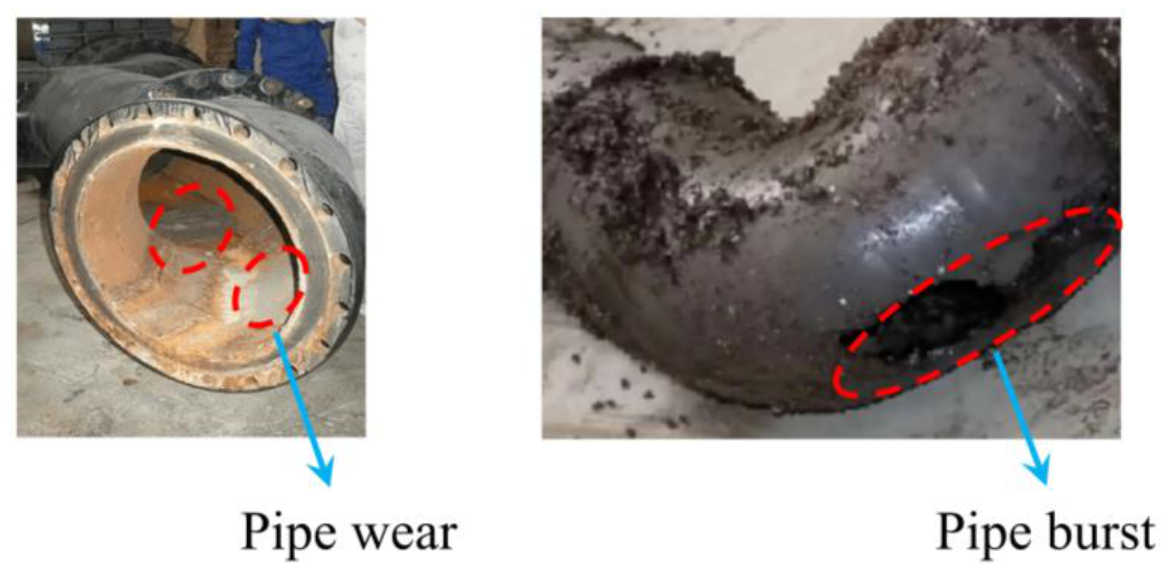
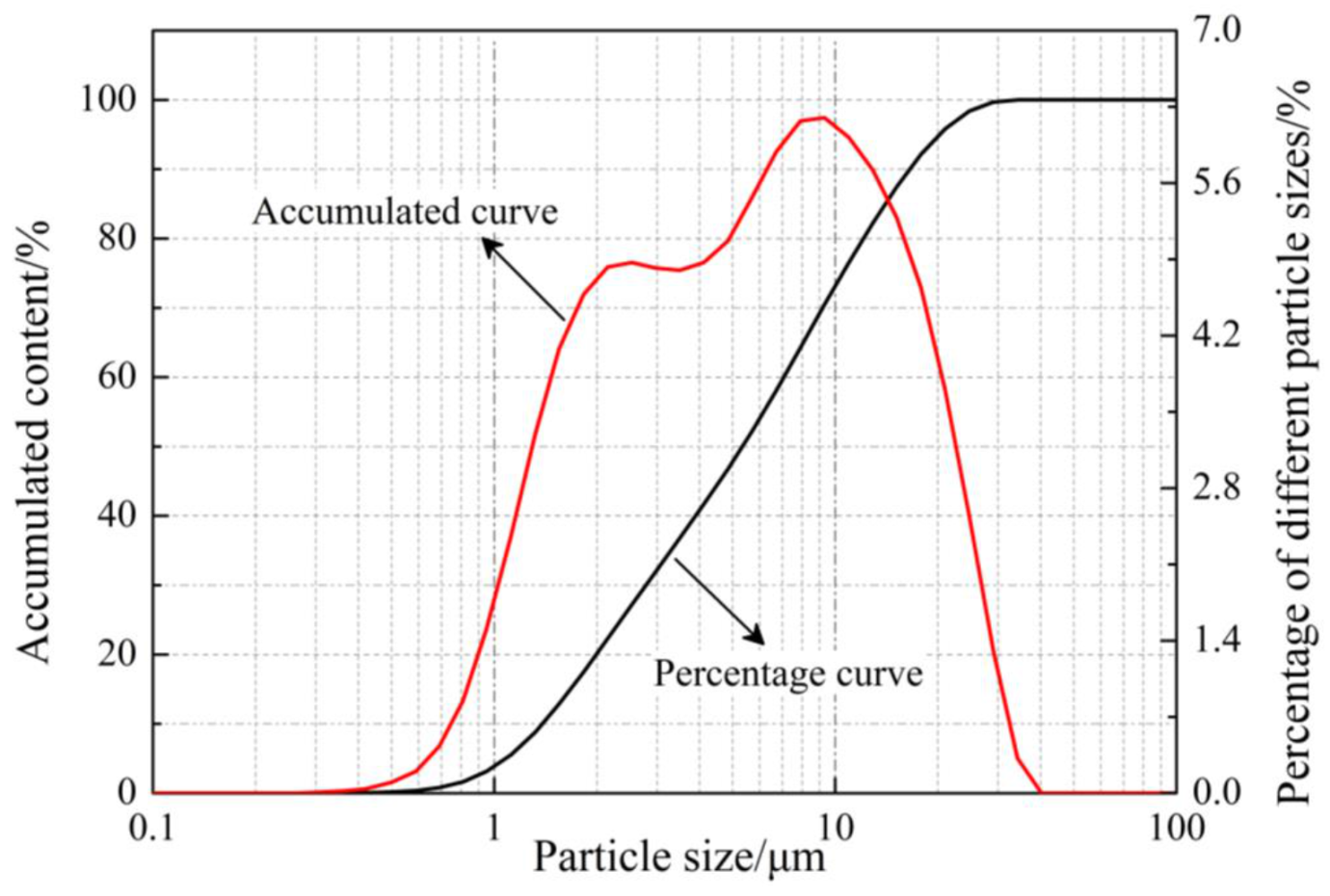
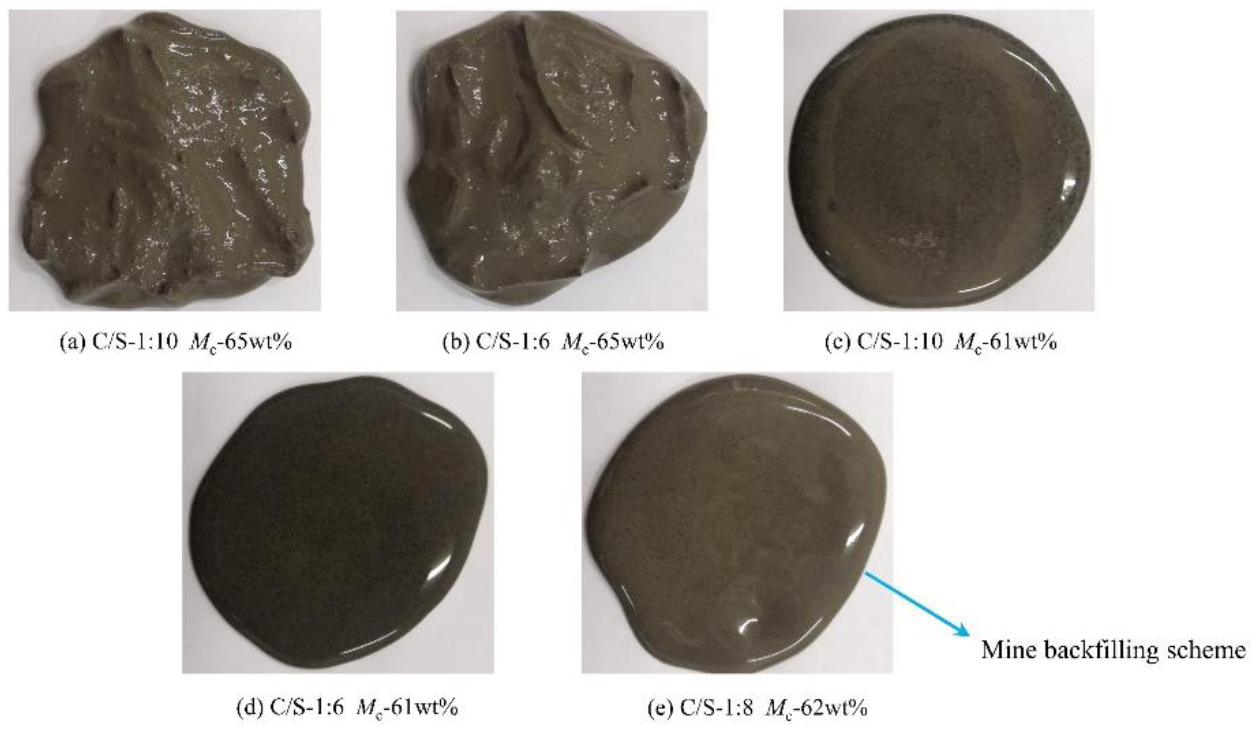

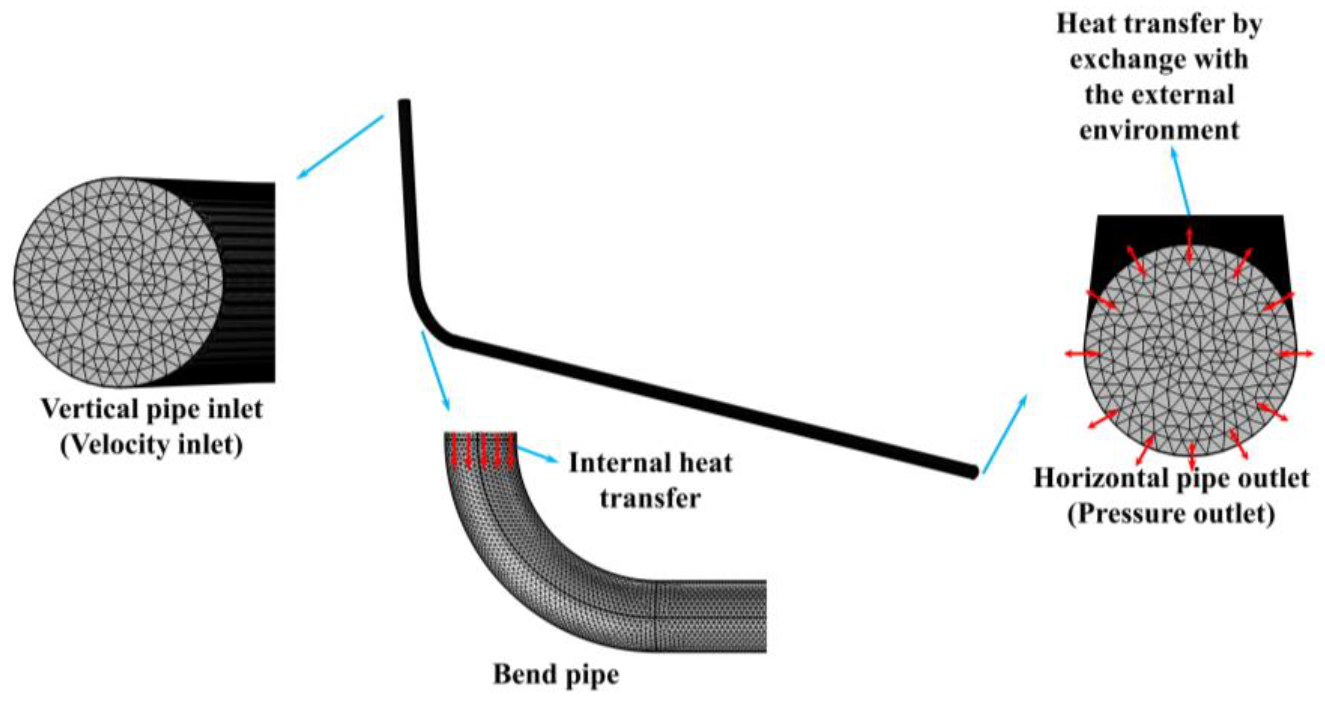

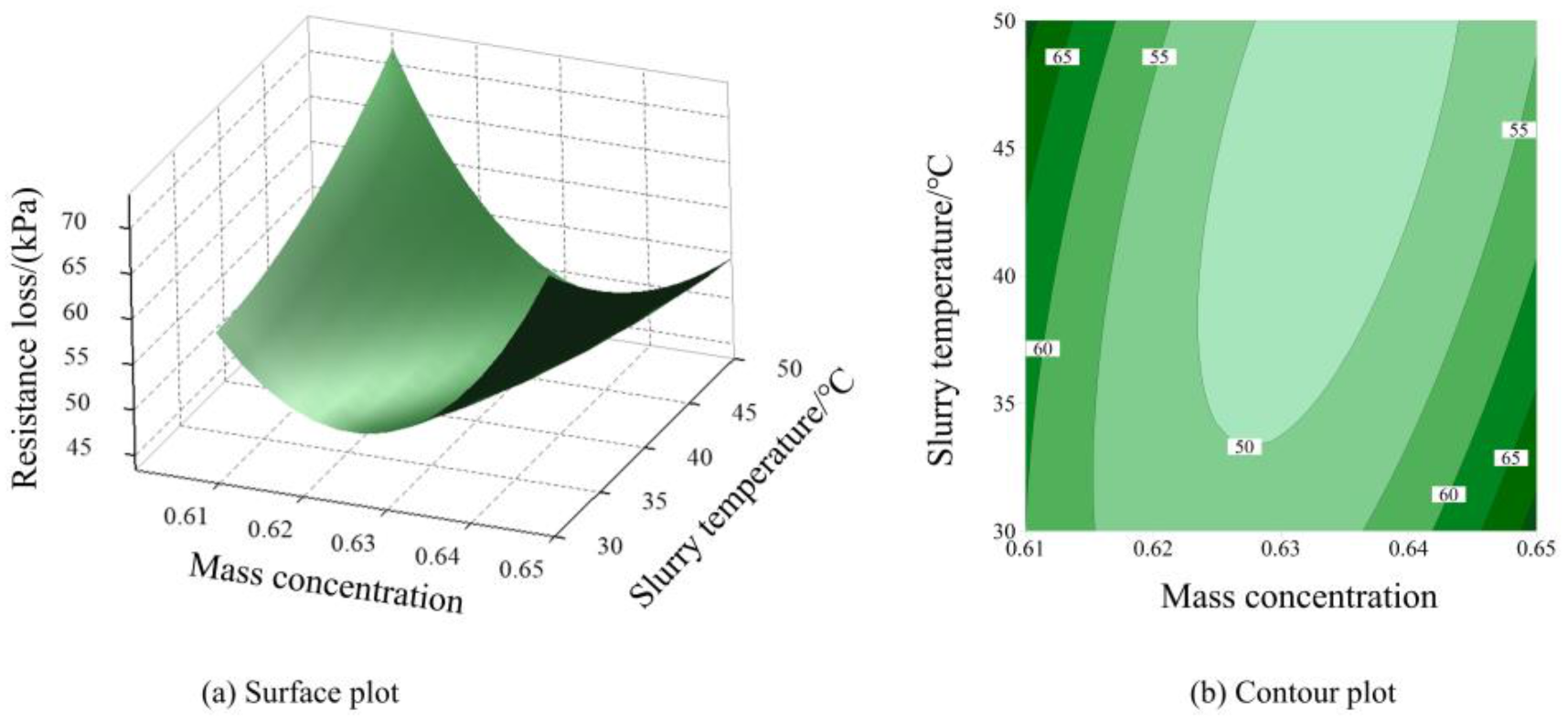
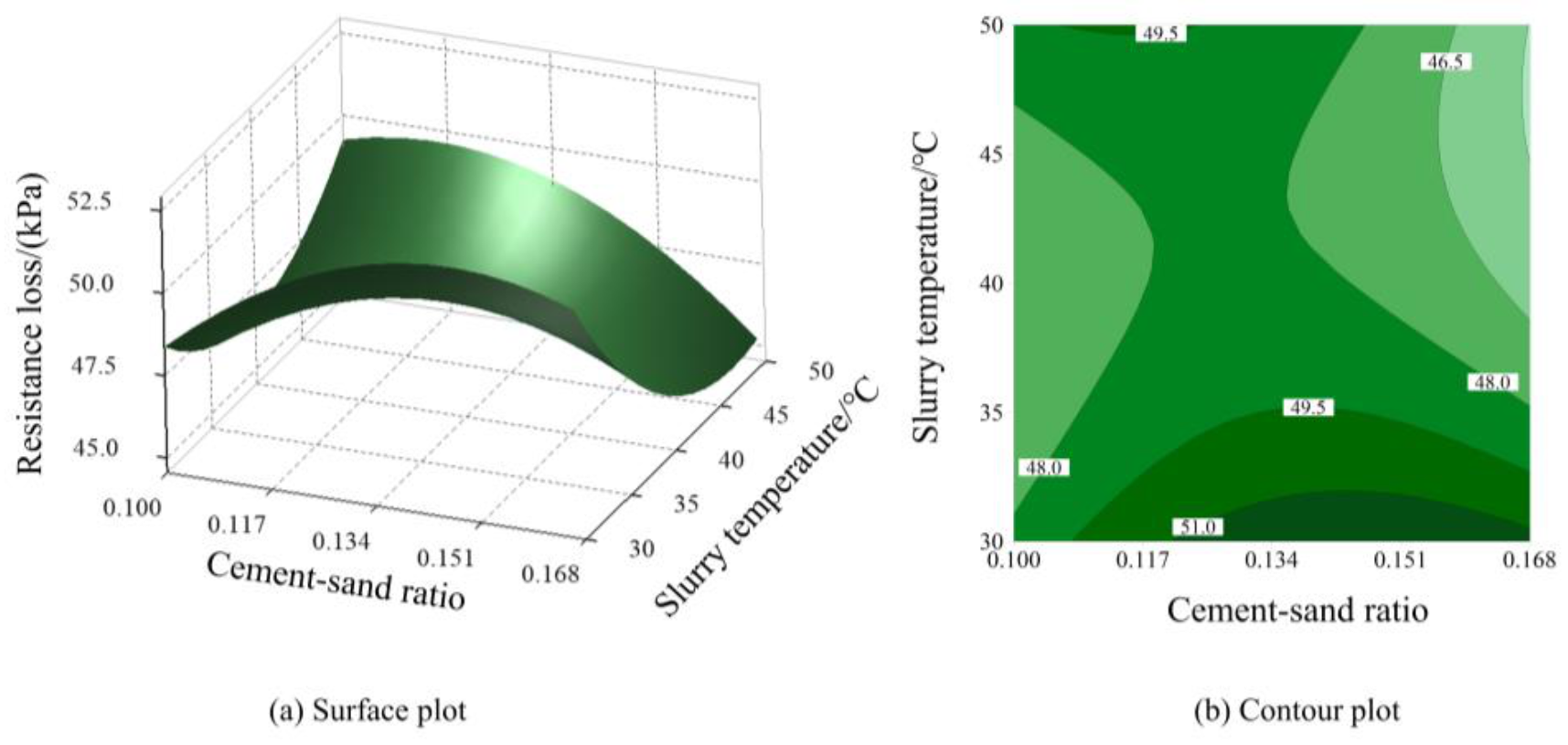

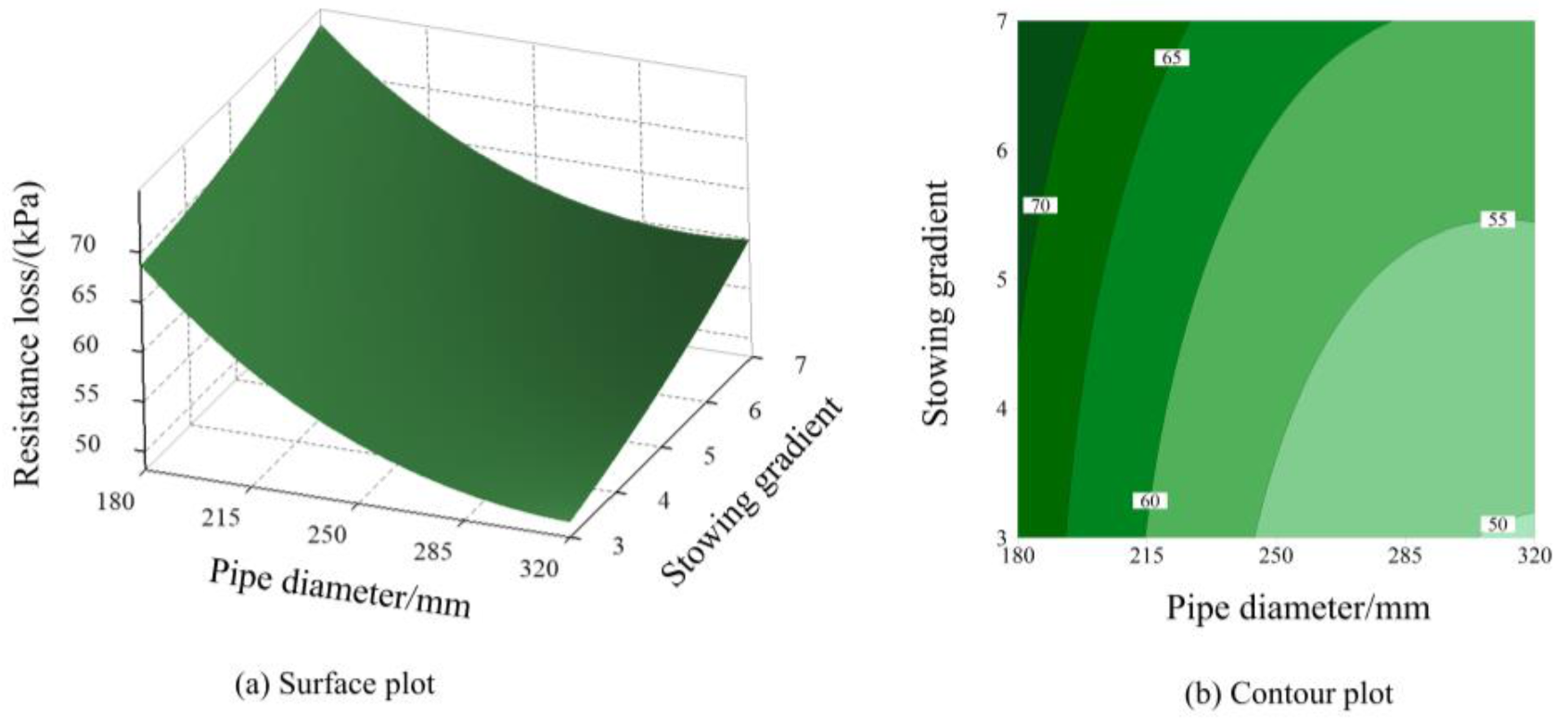
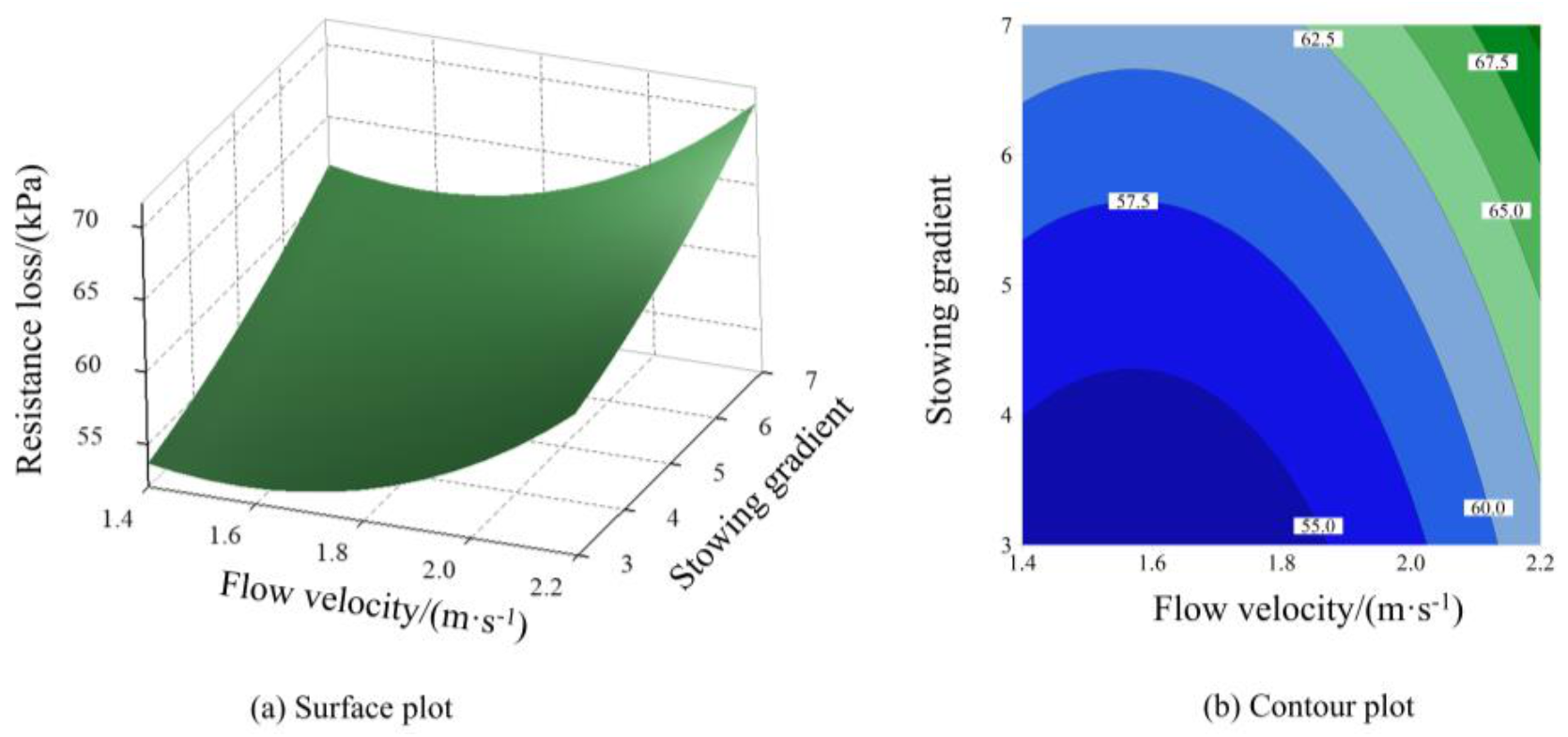
| Parameter Type | Parameter Name | Parameter Value |
|---|---|---|
| Slurry Properties | Mass concentration/wt% | 62 |
| Cement–sand ratio | 1:8 | |
| Slurry temperature/°C | 25 | |
| Pipe transport parameters | Pipe diameter/mm | 200 |
| Flow velocity/(m·s−1) | 1.5 | |
| Stowing gradient | 5 |
| d10/μm | d30/μm | d60/μm | PW/μm | Sw /μm | Cc | Cn |
|---|---|---|---|---|---|---|
| 1.39 | 2.67 | 7.10 | 7.29 | 6.715 | 0.72 | 5.10 |
| Chemical Composition | TFe | SiO2 | CaO | MgO | Al2O3 |
|---|---|---|---|---|---|
| Content | 6.00% | 67.58% | 4.04% | 5.60% | 7.30% |
| Cement–Sand Ratio | Mass Concentration | Slurry Temperature/°C | Plastic Viscosity/Pa·s | Yield Stress/Pa |
|---|---|---|---|---|
| 1:6 | 61 wt% | 30 | 0.696 | 33.927 |
| 40 | 0.669 | 31.661 | ||
| 50 | 0.654 | 30.001 | ||
| 1:6 | 63 wt % | 30 | 0.802 | 47.905 |
| 40 | 0.762 | 43.177 | ||
| 50 | 0.743 | 34.770 | ||
| 1:6 | 65 wt % | 30 | 1.091 | 102.753 |
| 40 | 0.902 | 82.224 | ||
| 50 | 0.890 | 74.248 | ||
| 1:8 | 61 wt% | 30 | 0.643 | 23.296 |
| 40 | 0.535 | 10.455 | ||
| 50 | 0.468 | 9.268 | ||
| 1:8 | 63 wt% | 30 | 0.711 | 41.407 |
| 40 | 0.664 | 37.315 | ||
| 50 | 0.635 | 31.511 | ||
| 1:8 | 65 wt% | 30 | 0.784 | 98.588 |
| 40 | 0.722 | 80.211 | ||
| 50 | 0.703 | 71.863 | ||
| 1:10 | 61 wt% | 30 | 0.636 | 16.108 |
| 40 | 0.519 | 9.654 | ||
| 50 | 0.446 | 6.837 | ||
| 1:10 | 63 wt% | 30 | 0.682 | 40.323 |
| 40 | 0.633 | 33.015 | ||
| 50 | 0.621 | 30.044 | ||
| 1:10 | 65 wt% | 30 | 0.736 | 86.201 |
| 40 | 0.715 | 78.875 | ||
| 50 | 0.698 | 67.014 |
| Factor Type | Test Factors | Factor Values |
|---|---|---|
| Endogenous effect | Mass concentration/wt% | 61, 63, 65 |
| Cement–sand ratio | 1:10, 1:8, 1:6 | |
| Slurry temperature/°C | 30, 40, 50 | |
| Exogenous effect | Pipe diameter/mm | 180, 250, 320 |
| Flow velocity/(m·s−1) | 1.4, 1.8, 2.2 | |
| Stowing gradient | 3, 5, 7 |
| Test Level Code | Mass Concentration/wt% | Cement–Sand Ratio | Slurry Temperature/°C |
|---|---|---|---|
| −1 | 61 | 1:10 | 30 |
| 0 | 63 | 1:8 | 40 |
| 1 | 65 | 1:6 | 50 |
| Standard | Running | Mass Concentration/wt% | Cement–Sand Ratio | Slurry Temperature/°C | Resistance loss/kPa |
|---|---|---|---|---|---|
| 13 | 1 | 63 | 1:8 | 30 | 49.068 |
| 10 | 2 | 65 | 1:8 | 40 | 56.422 |
| 6 | 3 | 65 | 1:10 | 50 | 47.354 |
| 20 | 4 | 63 | 1:8 | 40 | 48.889 |
| 12 | 5 | 63 | 1:6 | 40 | 41.982 |
| 4 | 6 | 65 | 1:6 | 30 | 84.032 |
| 5 | 7 | 61 | 1:10 | 50 | 74.382 |
| 2 | 8 | 65 | 1:10 | 30 | 61.268 |
| 18 | 9 | 63 | 1:8 | 40 | 48.686 |
| 1 | 10 | 61 | 1:10 | 30 | 61.246 |
| 15 | 11 | 63 | 1:8 | 40 | 48.579 |
| 8 | 12 | 65 | 1:6 | 50 | 57.843 |
| 17 | 13 | 63 | 1:8 | 40 | 46.778 |
| 9 | 14 | 61 | 1:8 | 40 | 70.212 |
| 19 | 15 | 63 | 1:8 | 40 | 49.976 |
| 3 | 16 | 61 | 1:6 | 30 | 53.557 |
| 16 | 17 | 63 | 1:8 | 40 | 42.796 |
| 7 | 18 | 61 | 1:6 | 50 | 59.273 |
| 14 | 19 | 63 | 1:8 | 50 | 54.105 |
| 11 | 20 | 63 | 1:10 | 40 | 53.287 |
| Test Level Code | Pipe Diameter/mm | Flow Velocity/(m·s−1) | Stowing Gradient |
|---|---|---|---|
| −1 | 180 | 1.4 | 3 |
| 0 | 250 | 1.8 | 5 |
| 1 | 320 | 2.2 | 7 |
| Standard | Running | Pipe Diameter/mm | Flow Velocity/(m·s−1) | Stowing Gradient | Resistance Loss/kPa |
|---|---|---|---|---|---|
| 14 | 1 | 250 | 1.8 | 7 | 61.668 |
| 13 | 2 | 250 | 1.8 | 3 | 53.881 |
| 3 | 3 | 180 | 2.2 | 3 | 81.591 |
| 11 | 4 | 250 | 1.4 | 5 | 57.865 |
| 5 | 5 | 180 | 1.4 | 7 | 71.851 |
| 6 | 6 | 320 | 1.4 | 7 | 60.908 |
| 4 | 7 | 320 | 2.2 | 3 | 55.242 |
| 2 | 8 | 320 | 1.4 | 3 | 50.648 |
| 16 | 9 | 250 | 1.8 | 5 | 59.758 |
| 9 | 10 | 180 | 1.8 | 5 | 70.470 |
| 10 | 11 | 320 | 1.8 | 5 | 53.326 |
| 17 | 12 | 250 | 1.8 | 5 | 58.211 |
| 7 | 13 | 180 | 2.2 | 7 | 88.090 |
| 19 | 14 | 250 | 1.8 | 5 | 59.779 |
| 15 | 15 | 250 | 1.8 | 5 | 55.443 |
| 20 | 16 | 250 | 1.8 | 5 | 54.598 |
| 18 | 17 | 250 | 1.8 | 5 | 57.691 |
| 8 | 18 | 320 | 2.2 | 7 | 66.911 |
| 1 | 19 | 180 | 1.4 | 3 | 65.410 |
| 12 | 20 | 250 | 2.2 | 5 | 63.180 |
| Source | Freedom | Sum of Squares | Mean Square | F Value | p Value | Remark |
|---|---|---|---|---|---|---|
| Regression model | 9 | 7.95182 | 0.88354 | 7.95 | 0.002 | Significant |
| Mass concentration | 1 | 2.31909 | 2.31909 | 20.88 | 0.001 | Significant |
| Cement–sand ratio | 1 | 0.99367 | 0.99367 | 8.94 | 0.014 | Significant |
| Slurry temperature | 1 | 1.25576 | 1.25576 | 11.30 | 0.007 | Significant |
| Mass concentration and Mass concentration | 1 | 2.32648 | 2.32648 | 20.94 | 0.001 | Significant |
| Cement–sand ratio and Cement–sand ratio | 1 | 0.05087 | 0.05087 | 0.46 | 0.514 | - |
| Slurry temperature and Slurry temperature | 1 | 0.06579 | 0.06579 | 0.59 | 0.459 | - |
| Mass concentration and Cement–sand ratio | 1 | 1.52852 | 1.52852 | 13.76 | 0.004 | Significant |
| Mass concentration and Slurry temperature | 1 | 1.69885 | 1.69885 | 15.29 | 0.003 | Significant |
| Cement–sand ratio and Slurry temperature | 1 | 0.13348 | 0.13348 | 1.20 | 0.299 | - |
| Source | Freedom | Sum of Squares | Mean Square | F Value | p Value | Remark |
|---|---|---|---|---|---|---|
| Regression model | 9 | 0.378403 | 0.042045 | 45.23 | <10−4 | Extremely significant |
| Pipe diameter | 1 | 0.186257 | 0.186257 | 200.36 | <10−4 | Extremely significant |
| Flow velocity | 1 | 0.048095 | 0.048095 | 51.74 | <10−4 | Extremely significant |
| Stowing gradient | 1 | 0.046464 | 0.046464 | 49.98 | <10−4 | Extremely significant |
| Pipe diameter and Pipe diameter | 1 | 0.015281 | 0.015281 | 16.44 | 0.002 | significant |
| Flow velocity and Flow velocity | 1 | 0.010162 | 0.010162 | 10.93 | 0.008 | significant |
| Stowing gradient and Stowing gradient | 1 | 0.000465 | 0.000465 | 0.50 | 0.495 | - |
| Pipe diameter and Flow velocity | 1 | 0.007441 | 0.007441 | 8.00 | 0.018 | significant |
| Pipe diameter and Stowing gradient | 1 | 0.005281 | 0.005281 | 5.68 | 0.038 | significant |
| Flow velocity and Stowing gradient | 1 | 0.000013 | 0.000013 | 0.01 | 0.909 | - |
| Test Type | Pipe Diameter/mm | Flow Velocity/(m·s−1) | Stowing Gradient | Mass Concentration/wt% | Cement–Sand Ratio | Slurry Temperature/°C | Resistance Loss/kPa |
|---|---|---|---|---|---|---|---|
| Endogenous optimization | 200 | 1.5 | 5 | 62.9 | 1:6 | 47.2 | 45.49 |
| 43.66 | |||||||
| 46.38 | |||||||
| 42.03 | |||||||
| 46.42 | |||||||
| Exogenous optimization | 320 | 1.67 | 3 | 62 | 1:8 | 25 | 48.33 |
| 51.50 | |||||||
| 44.42 | |||||||
| 49.07 | |||||||
| 49.65 |
| Test Type | n | p | FitSE | MSE | m | t0.975(10) | Resistance Loss Mean Value/kPa | 95% Confidence Interval |
|---|---|---|---|---|---|---|---|---|
| Endogenous | 20 | 10 | 0 | 0.333305 | 5 | 2.228 | 44.80 | (37.15, 48.65) |
| Exogenous | 20 | 10 | 0 | 0.030489 | 5 | 2.228 | 48.59 | (46.62, 50.10) |
Publisher’s Note: MDPI stays neutral with regard to jurisdictional claims in published maps and institutional affiliations. |
© 2022 by the authors. Licensee MDPI, Basel, Switzerland. This article is an open access article distributed under the terms and conditions of the Creative Commons Attribution (CC BY) license (https://creativecommons.org/licenses/by/4.0/).
Share and Cite
Sun, H.; Gan, D.; Xue, Z.; Zhang, Y. Categorization of Factors Affecting the Resistance and Parameters Optimization of Ultra-Fine Cemented Paste Backfill Pipeline Transport. Buildings 2022, 12, 1697. https://doi.org/10.3390/buildings12101697
Sun H, Gan D, Xue Z, Zhang Y. Categorization of Factors Affecting the Resistance and Parameters Optimization of Ultra-Fine Cemented Paste Backfill Pipeline Transport. Buildings. 2022; 12(10):1697. https://doi.org/10.3390/buildings12101697
Chicago/Turabian StyleSun, Haikuan, Deqing Gan, Zhenlin Xue, and Yajie Zhang. 2022. "Categorization of Factors Affecting the Resistance and Parameters Optimization of Ultra-Fine Cemented Paste Backfill Pipeline Transport" Buildings 12, no. 10: 1697. https://doi.org/10.3390/buildings12101697
APA StyleSun, H., Gan, D., Xue, Z., & Zhang, Y. (2022). Categorization of Factors Affecting the Resistance and Parameters Optimization of Ultra-Fine Cemented Paste Backfill Pipeline Transport. Buildings, 12(10), 1697. https://doi.org/10.3390/buildings12101697







